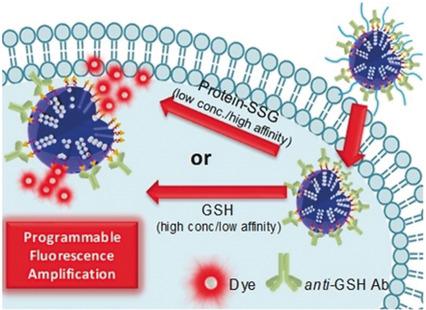当前位置:
X-MOL 学术
›
Angew. Chem. Int. Ed.
›
论文详情
Our official English website, www.x-mol.net, welcomes your
feedback! (Note: you will need to create a separate account there.)
Nanoquencher‐Based Selective Imaging of Protein Glutathionylation in Live Mammalian Cells
Angewandte Chemie International Edition ( IF 16.1 ) Pub Date : 2018-07-13 , DOI: 10.1002/anie.201806710 Xin Mao 1 , Peiyan Yuan 1 , Changmin Yu 2 , Lin Li 2 , Shao Q. Yao 1
Angewandte Chemie International Edition ( IF 16.1 ) Pub Date : 2018-07-13 , DOI: 10.1002/anie.201806710 Xin Mao 1 , Peiyan Yuan 1 , Changmin Yu 2 , Lin Li 2 , Shao Q. Yao 1
Affiliation

|
Changes in the cellular levels of glutathione (GSH) and protein S‐glutathionylation (PSSG) are closely associated with a number of human diseases. Despite recent advances, few thiol‐reactive, small‐molecule GSH sensors could selectively detect GSH over other endogenous thiols, and none was capable of detecting PSSG in live mammalian cells. By using a dye‐loaded mesoporous silica nanoquencher (qMSN) capped with anti‐GSH antibody capable of highly selective binding toward GSH and glutathionylated proteins over other molecules, we have successfully developed a fluorescence GSH/PSSG nanosensor, which showed unprecedented selectivity toward PSSG even in the presence of GSH, had amplifiable and programmable fluorescence Turn‐ON properties, and could be used to image endogenous PSSG in live mammalian cells under stimulated conditions for the first time.
中文翻译:

基于Nanoquencher的哺乳动物细胞中蛋白质谷胱甘肽化的选择性成像
谷胱甘肽(GSH)和蛋白S-谷胱甘肽化(PSSG)的细胞水平变化与许多人类疾病密切相关。尽管有最近的进展,但很少有能与硫醇反应的小分子GSH传感器比其他内源性硫醇选择性地检测GSH,而且没有一个能够检测活哺乳动物细胞中的PSSG。通过使用载有抗GSH抗体的染料负载介孔二氧化硅纳米猝灭剂(qMSN),该抗体能够与其他分子高度结合GSH和谷胱甘肽化蛋白,我们成功开发了荧光GSH / PSSG纳米传感器,即使对PSSG也显示出前所未有的选择性在GSH存在下,具有可放大和可编程的荧光Turn-ON特性,并且首次可用于在刺激条件下对活的哺乳动物细胞中的内源PSSG进行成像。
更新日期:2018-07-13
中文翻译:

基于Nanoquencher的哺乳动物细胞中蛋白质谷胱甘肽化的选择性成像
谷胱甘肽(GSH)和蛋白S-谷胱甘肽化(PSSG)的细胞水平变化与许多人类疾病密切相关。尽管有最近的进展,但很少有能与硫醇反应的小分子GSH传感器比其他内源性硫醇选择性地检测GSH,而且没有一个能够检测活哺乳动物细胞中的PSSG。通过使用载有抗GSH抗体的染料负载介孔二氧化硅纳米猝灭剂(qMSN),该抗体能够与其他分子高度结合GSH和谷胱甘肽化蛋白,我们成功开发了荧光GSH / PSSG纳米传感器,即使对PSSG也显示出前所未有的选择性在GSH存在下,具有可放大和可编程的荧光Turn-ON特性,并且首次可用于在刺激条件下对活的哺乳动物细胞中的内源PSSG进行成像。











































 京公网安备 11010802027423号
京公网安备 11010802027423号